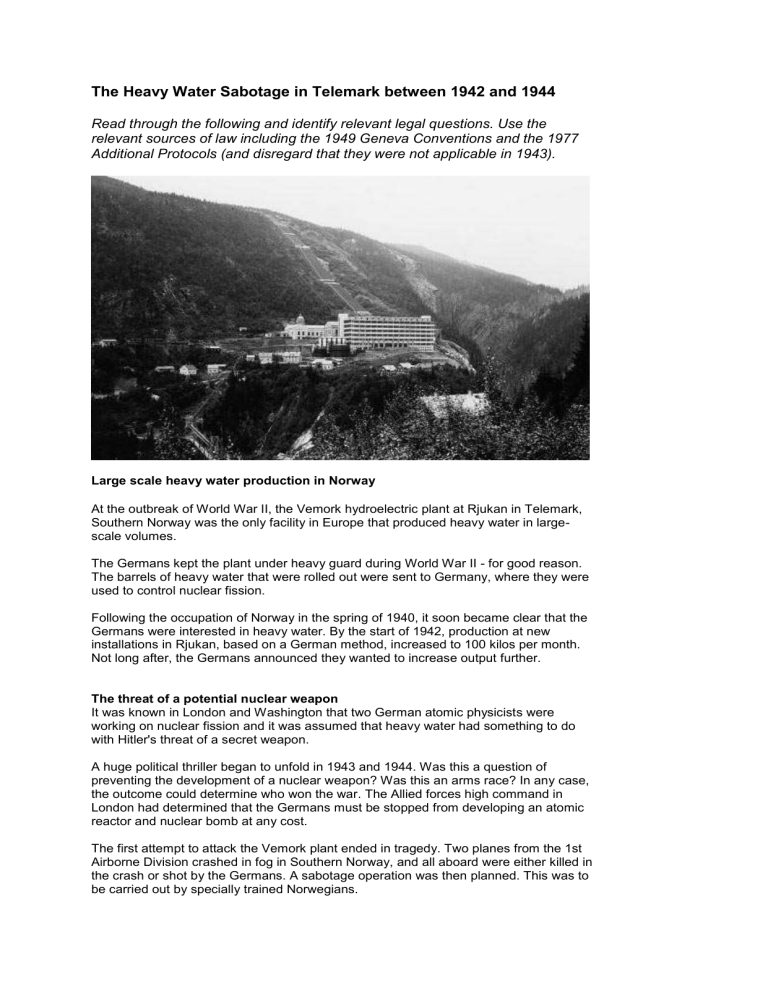The Heavy Water Sabotage in Telemark between 1942 and 1944

The Heavy Water Sabotage in Telemark between 1942 and 1944
Read through the following and identify relevant legal questions. Use the relevant sources of law including the 1949 Geneva Conventions and the 1977
Additional Protocols (and disregard that they were not applicable in 1943).
Large scale heavy water production in Norway
At the outbreak of World War II, the Vemork hydroelectric plant at Rjukan in Telemark,
Southern Norway was the only facility in Europe that produced heavy water in largescale volumes.
The Germans kept the plant under heavy guard during World War II - for good reason.
The barrels of heavy water that were rolled out were sent to Germany, where they were used to control nuclear fission.
Following the occupation of Norway in the spring of 1940, it soon became clear that the
Germans were interested in heavy water. By the start of 1942, production at new installations in Rjukan, based on a German method, increased to 100 kilos per month.
Not long after, the Germans announced they wanted to increase output further.
The threat of a potential nuclear weapon
It was known in London and Washington that two German atomic physicists were working on nuclear fission and it was assumed that heavy water had something to do with Hitler's threat of a secret weapon.
A huge political thriller began to unfold in 1943 and 1944. Was this a question of preventing the development of a nuclear weapon? Was this an arms race? In any case, the outcome could determine who won the war. The Allied forces high command in
London had determined that the Germans must be stopped from developing an atomic reactor and nuclear bomb at any cost.
The first attempt to attack the Vemork plant ended in tragedy. Two planes from the 1st
Airborne Division crashed in fog in Southern Norway, and all aboard were either killed in the crash or shot by the Germans. A sabotage operation was then planned. This was to be carried out by specially trained Norwegians.
The planning of the sabotage of the Vemork plant
The sabotage of the Vemork power plant was planned by the British secret unit called the SOE (Special
Operations Executive). SOE was formed out of existing secret departments in the UK: Section D, a sub-section of the Secret
Intelligence Service (SIS, aka MI6 ); a department of the War Office known as MI R.
SOE was established for the purpose of conducting warfare by means other than direct military engagement. The mission of the
In 1990, the heavy water saboteurs met up again at Rjukan and followed the same route from the mountains to the Vemork plant.
SOE was to encourage and facilitate espionage and sabotage behind enemy lines and to serve as the core of a resistance movement in Britain itself in the possible event of an
Axis invasion. SOE was also known as Churchill's Secret Army and charged by him to
"set Europe ablaze" . SOE directly employed or controlled about 10,000 people in over 15 countries.
Norwegians in London assisted in the plans to sabotage the heavy water unit at the
Vemork power plant at Rjukan, and photographs and sketches of the plant were sent to
London by Norwegian contacts at the facility, in particular Jomar Brun, who was the manager of the heavy water unit at Vemork.
In October 1942, four SOE hand-picked trained Norwegian commandoes were dropped by parachute onto the Hardangervidda mountain plateau, a good distance to the west of
Rjukan and the Vemork plants. They stayed on the plateau, some 1,200 metres above sea level, throughout several winter months, eating nothing but moss for weeks before they finally shot a reindeer. In February an additional six SOE Norwegian commandoes were parachuted onto Hardangervidda to join the team.
To reach the Vemork plant, the group of saboteurs had to cross the river right at the bottom of the gorge, as they could not use the 75 meter long suspension bridge across the deep ravine. It was only after one of the commandoes, Claus Helberg, had been out on a couple reconnaissance missions in the area that the group decided that the seemingly impossible task of climbing across the gorge could be attempted.
Operation Gunnerside
One hour before midnight on February 27, the saboteurs climbed down the gorge and across the ice-choked river, edged up the rock face on the other side, and emerged by the railway track to the hydrogen plant. They found the path alongside the railway line, but felt reasonably sure that mines had been laid to protect the facility from intruders.
They cut the iron chain that blocked the way. Even before the group of commandoes had landed in Norway, SOE had a Norwegian agent, Jomar Brun, within the plant who supplied detailed plans and schedule information. The saboteurs used this information to enter the main basement by a cable tunnel and through a window.
Joakim Rønneberg and Hans Storhaug made it in this way and took the guard by surprise. Birger
Strømshaug, Fredrik Kayser and Kaspar Idland broke a window to get in, but the German guards heard nothing above the powerful drone of the generators.
Two of the saboteurs mounted the explosive charges. The fuses were about two minutes long, but they were cut down to 30 seconds and then lit.
Rønneberg had a key so they could get out fast, and they knew that their cover squad was in
The wrecked upgrading unit for heavy water is today exhibited in the Industrial
Workers Museum at Vemork. position. The German guards had been put out of action as they had been locked up in the guardhouse.
The charges blew, the sound of shattering glass again split the air, but the German guards can hardly have grasped that it was an explosion. A guard sauntered out, tried the door to the electrolyser facility, found it locked, and went back inside the guardhouse.
A short time later, he came out again with a torch and shined it along the ground. The
Germans must have thought the snow had triggered one of the mines to explode. The guard gave up and went back into the guardhouse again - and probably saved his life.
The saboteurs purposely left a British machine gun at the site to indicate that this was a
British raid and not local resistance, to try to prevent reprisals.
Full-scale search
By the time the Germans had realized what had happened and soldiers started streaming up to the Vemork plant, the saboteurs were already far down the railway line on their way to Rjukan. It was very dark and the snow was deep but they all got away.
Once back on the mountain plateau, the group split up. The explosives team travelled by ski, fully armed and in their camouflage uniforms, the 400 kilometres over the high country and across the valleys of Eastern Norway to Sweden. The others spread out over the plateau, and remained in Norway to carry out other operations under SOE command. The Germans brought in thousands of soldiers and organized an extensive search, but were unable to find any of the saboteurs.
The action destroyed the facility and large quantities of heavy water only for a period of time.
Many killed in bomb raid
The heavy water plant was rebuilt and production restarted during the next six months. The Allied forces worried about German nuclear capability and research and decided to destroy all facilities with capabilities to develop nuclear power, including the Vemork power plant. Before dawn on the 16
November 1943, 161 Allied
Bombers took off from their bases in east Anglia in the direction of
Norway. In order to limit civilian losses the attacks were scheduled to take place at noon, when many of the workers would be out for their lunch breaks. At 11.45 the first of the 143 B-17 Bombers came over Vemork at an altitude of
12.000 feet. They dropped 711 bombs of 500 kilos each during the first fifteen minutes. Because of smoke and poor visibility 13 bombers did not let go of their cargo over Vemork but dropped the bombs into the ocean on their way home. 70 tons of bombs were
The Rjukan plants were heavily bombed in the autumn of 1943. The damage was extensive. dropped, but only 18 bombs hit the
Vemork plant. The bombs were spread over a large area. Bombs were found more than 30 kilometres from the target area. Six civilian houses were destroyed and several damaged. One bomb hit a bomb shelter, killing all of its occupants, mostly women and children. A total of 22 civilians were killed in the attack.
The damages were sufficient to convince the Germans to terminate the heavy water production at Vemork. The Norwegian London based Government had not been consulted before the attack, and there were strong reactions from Norway, condemning
“precision” bombing from such altitudes.
"Hydro" sinks to bottom of the Tinnsjø lake
A couple of months later, SOE intelligence agents in Rjukan discovered that the
Germans planned to ship all the semi-finished products from Vemork to research centres in Germany. The Allied forces were still concerned that the Germans possibly could use heavy water to develop nuclear weapons, although this was seen as unlikely.
Orders came by radio from London to destroy the cargo during transport. The weakest link was the journey by the train ferry "Hydro" over the Tinnsjø lake. The heavy water cargo was closely guarded at all times, but the boat that was to transport the shipment stood unwatched the night before. One of the three SOE saboteurs had experimented with a timer and detonating mechanism, and he tried to set the explosion to go off when it would be easiest to rescue passengers.
The ferry's departure was Sunday morning, 20 February 1944. Fortunately there were never many passengers on Sundays. The cargo was 53 passengers, some trucks including two trucks with 600 kilos of heavy water. The explosion came at 11 AM, when the ferry was at the deepest area of the lake. The bow was torn off and the ferry sank in a matter of minutes. 14 Norwegian civilians and 4 German soldiers died. The explosion on the Tinnsjø lake ended the last chapter in the story of heavy water sabotage in
Norway during the war.








